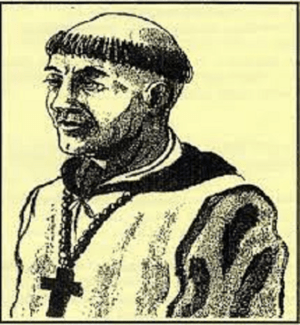Patrick O'Hely facts for kids
Quick facts for kids BlessedPatrick O'Hely (Irish: Pádraig Ó hÉilí) O.F.M. |
|
|---|---|
 |
|
| Bishop of Mayo, Martyr | |
| Born | between c. 1543 and c. 1546 Dromahair, County Leitrim, Ireland |
| Died | 31 August 1579 (aged between 33 - 36) Outside one of the gates of Kilmallock |
| Venerated in | Roman Catholic Church |
| Beatified | 27 September 1992 by Pope John Paul II |
| Feast | 31 August |
Patrick O'Hely (Irish: Pádraig Ó hÉilí) was an important Irish Catholic bishop. He was born around 1543 to 1546 and died on August 31, 1579. He served as the bishop of Mayo in Ireland. During a time of great change and conflict, he was executed by the English government because of his religious beliefs.
Contents
Patrick O'Hely's Life Story
Patrick O'Hely was born in Dromahair, a town in County Leitrim, Ireland. He grew up in the area known as Connacht. When he was young, he decided to join the Franciscans. This is a religious group within the Catholic Church.
Early Studies and Education
Just four years after joining the Franciscans, Patrick was sent to study in Spain. He attended the University of Alcalá, a famous school. There, he was known for being very good at his religious studies. He learned a lot about the Catholic faith.
Becoming a Bishop
Later, Patrick was called to Rome, the center of the Catholic Church. In 1576, he was chosen to become the Bishop of Mayo. This area later became part of the Archdiocese of Tuam. Pope Gregory XIII gave him special permission to lead services in nearby areas if no other Catholic bishop was available. The Pope also gave him money to help with his work.
Patrick also traveled to Paris, France. He took part in public debates at the Sorbonne university. People were amazed by how much he knew about theology (the study of religious faith) and philosophy.
Return to Ireland and Arrest
In the autumn of 1579, Patrick O'Hely sailed from Brittany (a region in France) back to Ireland. He arrived off the coast of County Kerry. This was a very difficult time in Ireland. There was a lot of fighting and rebellion against English rule.
Patrick and his friend, Conn O'Rourke, came ashore. Conn O'Rourke (whose Irish name was Conn Ó Ruairc) was also a Franciscan Friar. He was the son of a powerful Irish leader, Brian, Lord of Breifne.
The two men looked for a place to stay at Askeaton Castle. The Countess, whose husband was away, welcomed them. The next day, they left for Limerick. However, the Countess told the Lord Mayor of Limerick about them. Three days later, Patrick and Conn were captured. They were sent to Kilmallock, where an English army leader, Sir William Drury, was staying.
Trial and Execution
Sir William Drury was a very strict leader. He had executed many people in Ireland. He offered Bishop O'Hely a deal. He said O'Hely could keep his position as bishop if he agreed to support the Church of Ireland (the official church of England) and share information about the Pope's plans.
Bishop O'Hely refused. He said he could not trade his faith for his life or for power. He believed his job was to help the Catholic religion and save souls. When asked about plans for Spain or the Pope to invade Ireland, he stayed silent.
Because he refused to answer, Patrick O'Hely was tortured. Even after this, he still did not speak. So, he and Conn O'Rourke were quickly sentenced to death under "martial law." This meant they had a quick trial by military rules, not a regular court.
| Blessed Conn O'Rourke (Irish: Conn Ó Ruairc) O.F.M. |
|
|---|---|
| Franciscan friar, Martyr | |
| Born | c. 1549 Brefney, Ireland |
| Died | 31 August 1579 (aged 29 - 30) Outside one of the gates of Kilmallock |
| Venerated in | Roman Catholic Church |
| Beatified | 27 September 1992 by Pope John Paul II |
| Feast | 31 August |
Patrick O'Hely and Conn O'Rourke were hanged outside one of the gates of Kilmallock. This happened on August 31, 1579. Their bodies were left hanging for fourteen days.
Beatification
In September 1992, Pope John Paul II officially recognized Patrick O'Hely and Conn O'Rourke. He beatified them along with 15 other Irish Catholic Martyrs. Beatification is a step towards becoming a saint in the Catholic Church. It means they are recognized for their holy lives and for dying for their faith.

